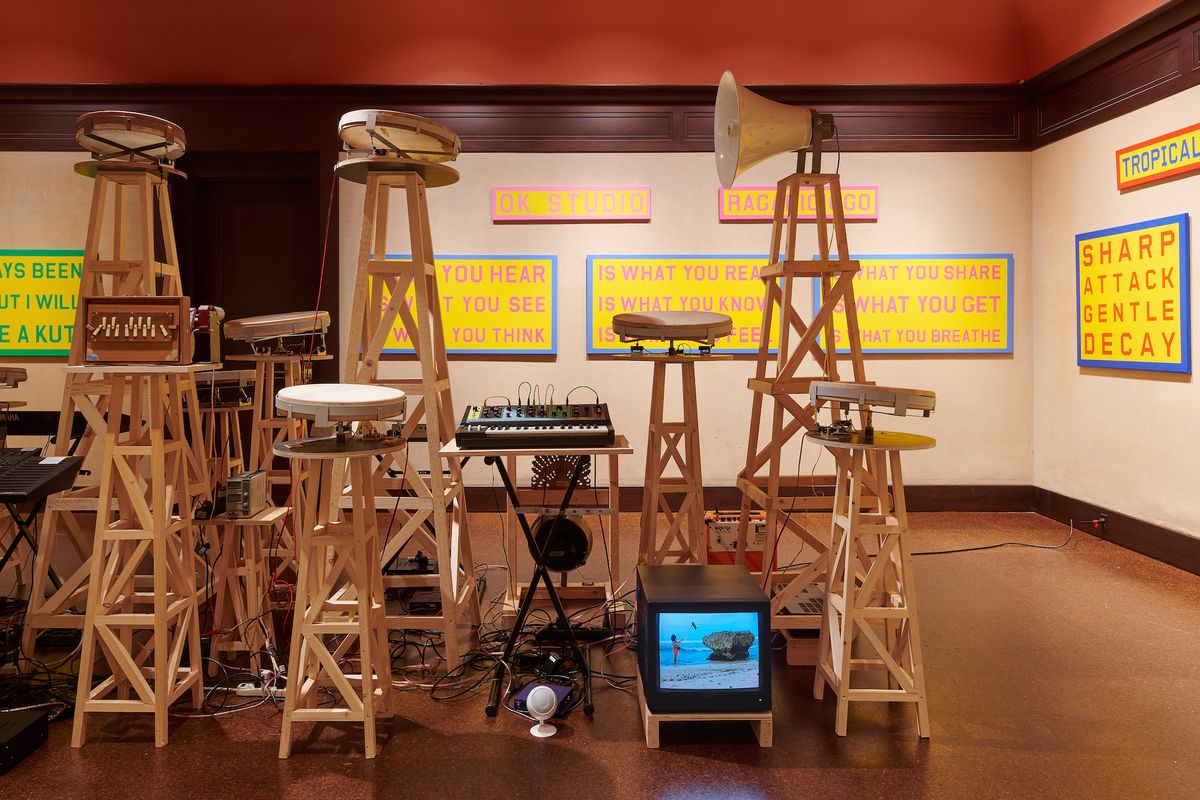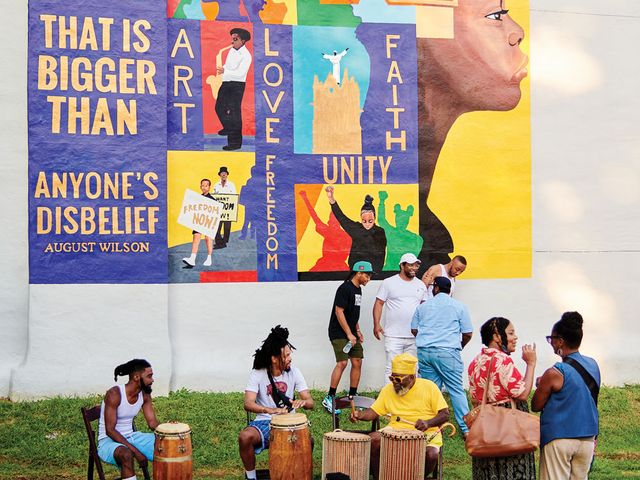In an opening passage of the catalogue for the 58th Carnegie International, which opened last month at Pittsburgh’s Carnegie Museum of Art, curator Sohrab Mohebbi remarks, “to be contemporary means to stand in solidarity, in art and life”. The statement is a reflection on a conversation between Mohebbi and one of the exhibition’s featured artists, Édgar Calel. In his indigenous Mayan Kaqchikel community in Guatemala, Calel explained, rather than saying “good morning”, it is customary to ask, “is it morning for you yet?” The phrase, which became the title of the exhibition (until 2 April 2023), acknowledges the present moment as a convergence of eras, perspectives and experiences. Its sentiment echoes as a poetic refrain throughout the sprawling quinquennial exhibition.
Curated by Mohebbi, who was recently appointed director of New York’s SculptureCenter, in collaboration with associate curator Ryan Inouye, curatorial assistant Talia Heiman and a global curatorial council, the exhibition traces the geopolitical imprint of the United States since 1945—the end of the Second World War and the beginning of the period in art history considered “contemporary”. This conceptual framework places the exhibition, which prominently features non-Western artists, in dialogue with the history of art, the Carnegie Museum and the city of Pittsburgh. But the exhibition operates more as a root system than as a lens, with the biennial-style format generating several overlapping branches of thought.
Rather than solely surveying artistic responses to the present day, as in previous Carnegie Internationals, Mohebbi’s curatorial approach broadens the exhibition’s scope to include historical works on loan from institutions and artists’ estates in tandem with new and commissioned contemporary works. Featuring over 100 artists and collectives, the exhibition manages to challenge existing frameworks while inspiring faith in art’s potential to illuminate marginalised voices and perspectives, facilitate connections across borders and envision a future that transcends deeply rooted hegemonic structures.
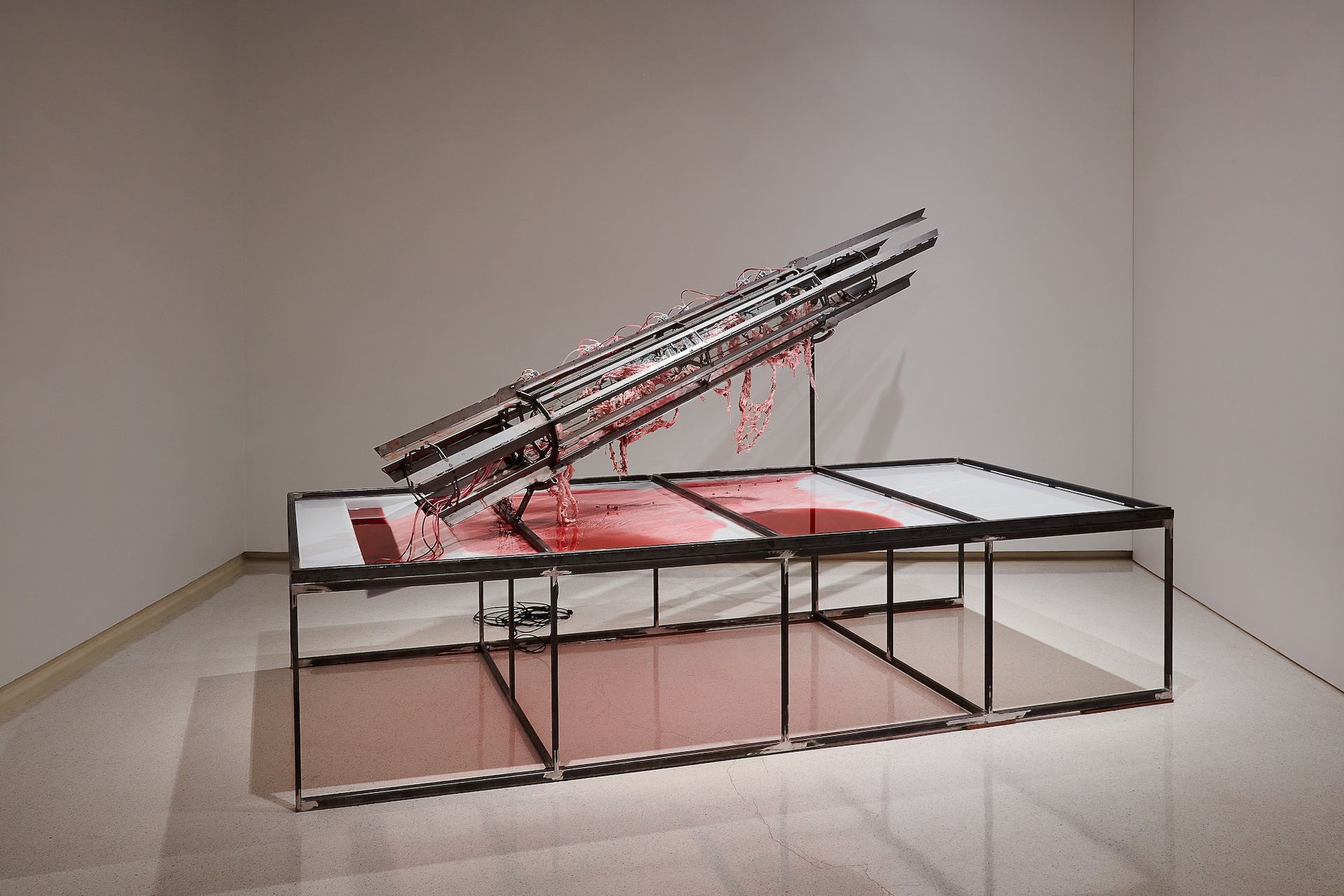
Mire Lee, installation view of Untitled (My Pittsburgh Sculpture) (2022) in the 58th Carnegie International Courtesy of the artist and Carnegie Museum of Art; photo: Sean Eaton
“We tried to follow the works and the thinking of the artists,” says Mohebbi. “It was our aim to acknowledge the interruptions, disruptions, devastations, and fractures of these geopolitical movements while insisting on the aesthetic currents that endured despite such disturbances.” Fittingly, the works included—spanning from a 1945 lithograph map by Louise E. Jefferson (Uprooted People of the USA, 1945) to an evocative steel and glass kinetic sculpture by South Korean artist Mire Lee that churns and excretes a sinuous pink mass of dripping silicone resembling human organs, probing the interplay of accumulated pain and generative beauty (Untitled; My Pittsburgh Sculpture, 2022)—as Mohebbi notes, “overwhelm the ambition of any one organisational intent.”
“Horizontal monumentality”
Broadly, the exhibition is most successful in its emphasis on dialogical exchange. Many of the commissioned works, such as New York-based Cuban artist Rafael Domenech’s temporary pavilion Dividing an edge from an ever (pavilion for Sarduy) (2022), were developed in conversation with the conceptual and spatial context.
Shaped like an ellipsis that opens outward toward the street behind the museum, Domenech’s installation punctuates the square-frame infrastructure of the Carnegie Museum’s Sculpture Court, creating a space for social engagement. The work, which Domenech refers to as a “collaborative publication”, was constructed from locally sourced scaffolding and overlapping layers of blue and orange construction mesh that was treated as a scroll of paper and run through a laser-cutter to inscribe a collective poem. In his process, Domenech reframes a material designed for dividing space and concealing sites of demolition and development in urban communities as a method for “exposing and creating new possibilities”.
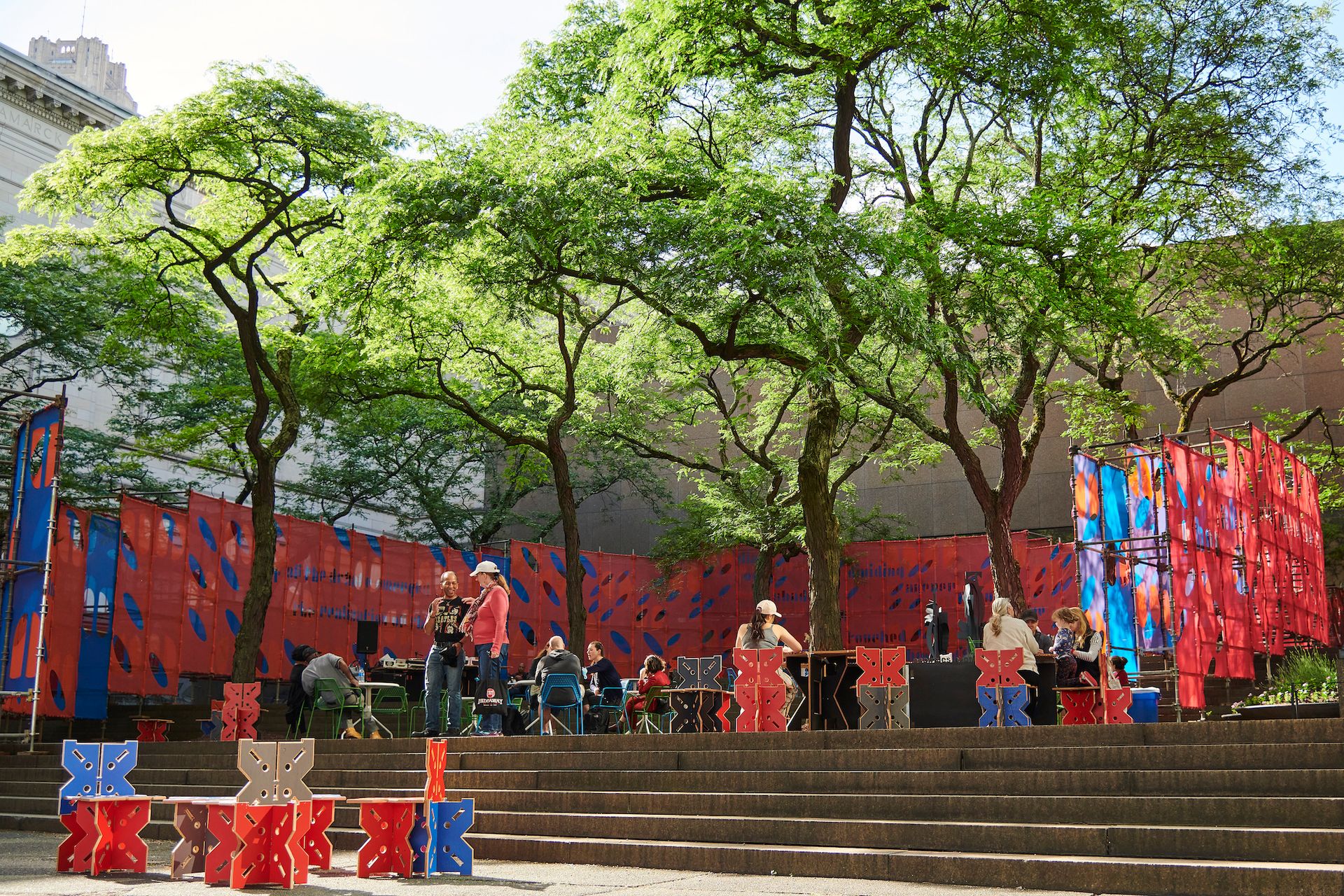
Installation view of Rafael Domenech, Dividing an edge from an ever (pavilion for Sarduy) at Carnegie Museum of Art, 2022 Photo: Sean Eaton.
“My project is about horizontal monumentality,” Domenech says. “It’s about relationships and networks and systems that overlap with no hierarchical system. I think the entire exhibition deals with that. It’s sharing human conditions in a universal way—not universal in the sense of standardisation, but in the sense of space, feelings and responses.”
Artistic solidarity
Inside, the sense of ample space is palpable. Works are spread out across several galleries so far that seeing everything requires some endurance, and indeed, overwhelms. At the top of the museum’s central stairway, the second-floor atrium serves as a portal between historical and recent works.
To the left, the Scaife wing—usually home to the museum’s permanent collection of (overwhelmingly North American and European) contemporary and modern art, including works by Rothko, De Kooning, Warhol and others—features three curated presentations of historical works: Refractions, conceived by the Carnegie International curatorial team; As if there is no sun, presented by Akmalia Rizqita, Grace Samboh and Ratna Mufida (collectively known as Hyphen—); and Spores of Solidarity, presented by the Museo de la Solidaridad Salvador Allende (MSSA) in Santiago, Chile.
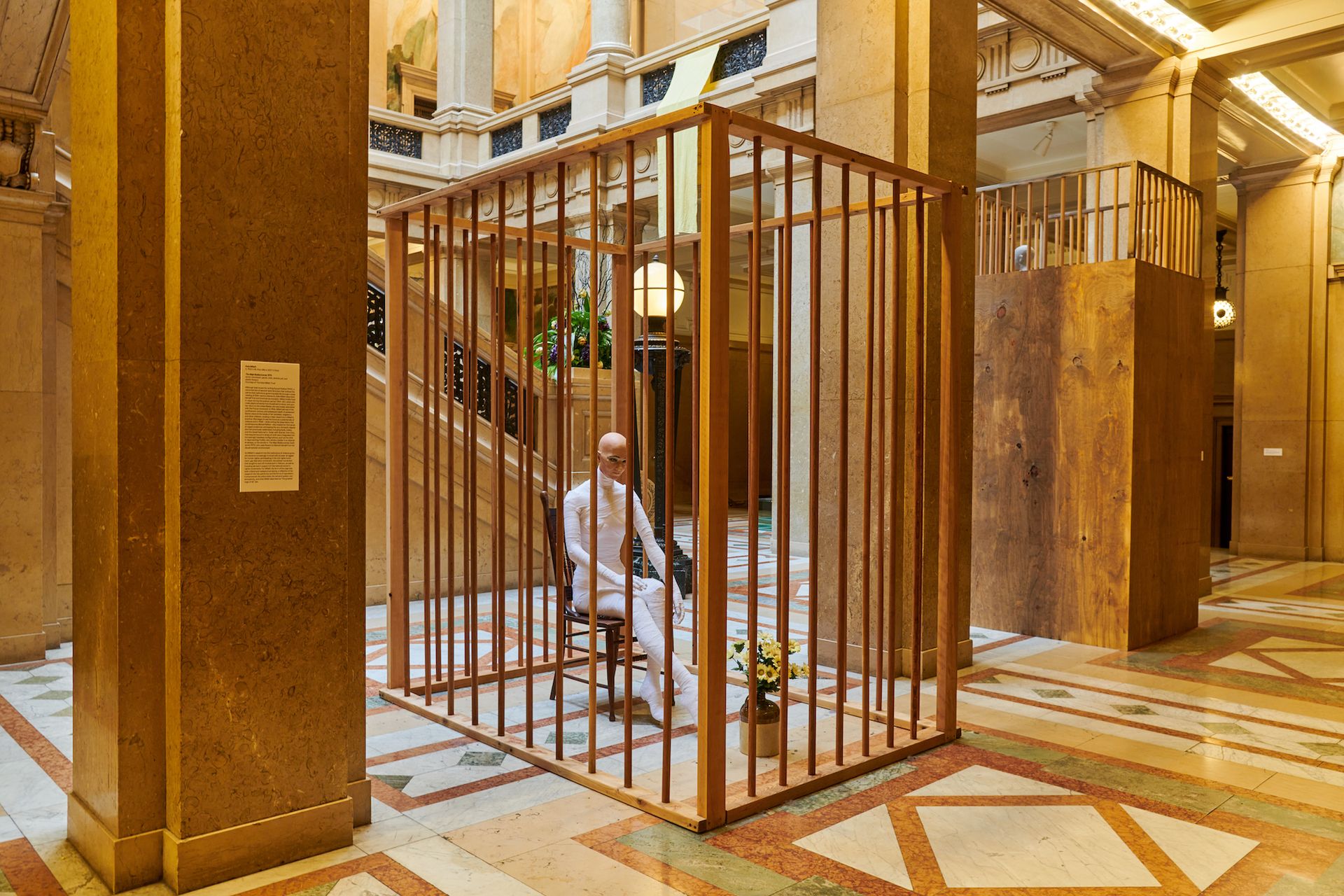
Installation view of Kate Millett, The Maja Rediscovered from Situations (1975) in the 58th Carnegie International at Carnegie Museum of Art, 2022 Courtesy of The Kate Millett Trust and Carnegie Museum of art; photo: Sean Eaton
The presentations operate in relation to one another, but also to the institutional setting. “The museum’s collection is a kind of living archive of the museum—a narration of its own history. So in a way, the International exhibition is always being staged in relation to history,” the museum’s director Eric Crosby says.
In three adjoining galleries on the far side of the Scaife wing is Refractions, a presentation of works dating from 1945 to 2021 that are on loan from public institutions and artists’ estates including pieces by Margarita Azurdia, Aziz Hazara, Felix Gonzalez-Torres, Denzil Forrester, Vandy Rattana and Claes Oldenberg.
“With Refractions, we are looking at instances of solidarity between artists or moments where artists, through their artwork, gestures, materials they use and the traditions they draw from are in conversation with each other,” says curator Ryan Inouye.
Displayed chronologically according to the dates they were created rather than the events they reference, the works offer global historical responses to systems of oppression while drawing connections between them, presenting the past as omnipresent rather than linear.
Toward the end of the presentation, Filipino artist Pio Abad’s Thoughtful Gifts (2020) excavates and memorialises incriminating correspondences between Ronald Reagan and Filipino dictator Ferdinand Marcos on engraved white Carrara marble tablets, documenting the shrouded collusions that uphold systems of power which pervade today.
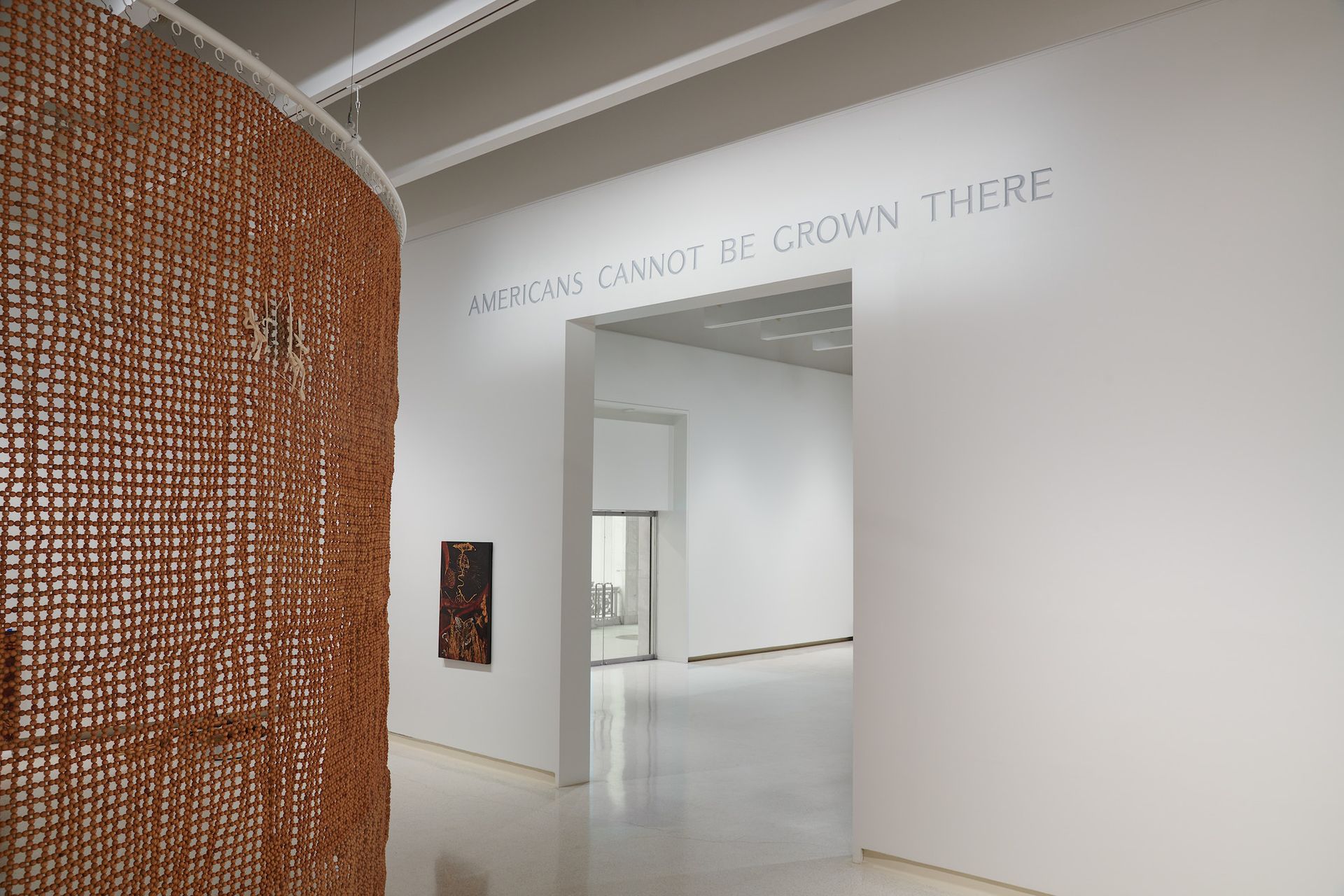
Pio Abad, installation view of Distant Possessions (2022) in the 58th Carnegie International Courtesy of the artist and Carnegie Museum of Art; photo: Sean Eaton
In the adjacent gallery, two presentations illuminate vital artistic contributions that have been suppressed by oppressive political structures and demonstrate art’s role in inspiring resistance and solidarity. As if there is no sun, curated by Hyphen—, highlights Indonesian painter Kustiyah (1935-2012) and her contemporaries, who depicted scenes from everyday life painted over the course of Indonesia’s revolutionary period, New Order regime and Reformasi period. Spores of Solidarity features works curated by Museo de la Solidaridad Salvador Allende, a modern and contemporary art museum in Santiago with an international collection of more than 3,000 works donated by artists to the people of Chile. After it was forced into exile by the CIA-backed coup in 1974, the collection was hosted by museums in Latin America, Asia, Africa and Europe before returning to Chile in 1991.
Some visitors to the current International may lack the historical, cultural and geographical contexts informing several of the featured works, which only underlines the pervasiveness of US hegemony—putting the US at the centre of the dominant narrative of global history told since 1945. Acknowledging this, the accompanying text offers brief but not extensive historical context, purposely subverting a political lens that might only serve to centre the oppressor, giving the works space to speak for themselves.
Entangled histories
The International’s surveys of historical works features direct links to specific events, but many of the new commissions favour abstraction, their socio-political framework inherent in our entangled, lived reality. The museum’s Heinz galleries host the new and recently commissioned works and open with a haunting, monochromatic, 20ft by 26ft floor installation by Iraqi artist Dia al-Azzawi depicting a bird’s eye view of the recent destruction of Mosul in Iraq and Aleppo in Syria. It is flanked on either side by Cologne-based artist Melike Kara’s excavation of her Alevi Kurdish roots: a wall-filling collection of photographs from the Kurdish diaspora. Painting over the images with bleach to ghostly effect, the artist grapples with the inability of the archival process to preserve a cohesive record of a fragmented population. The muted photographic composition mirrors al-Azzawi’s vacant grid, charting an expansive map of absence and erasure.
“Stories passed down orally change from generation to generation, from person to person, from group to group,” Kara says. “By focusing on my own personal story, I show a small part of the collective consciousness of an incredibly diverse group like the Kurds. In my art, I am trying to interweave threads from the past and present to form a new third entity. My work is never a precise representation of a Kurdish past or present, but always a new and separate thing.”
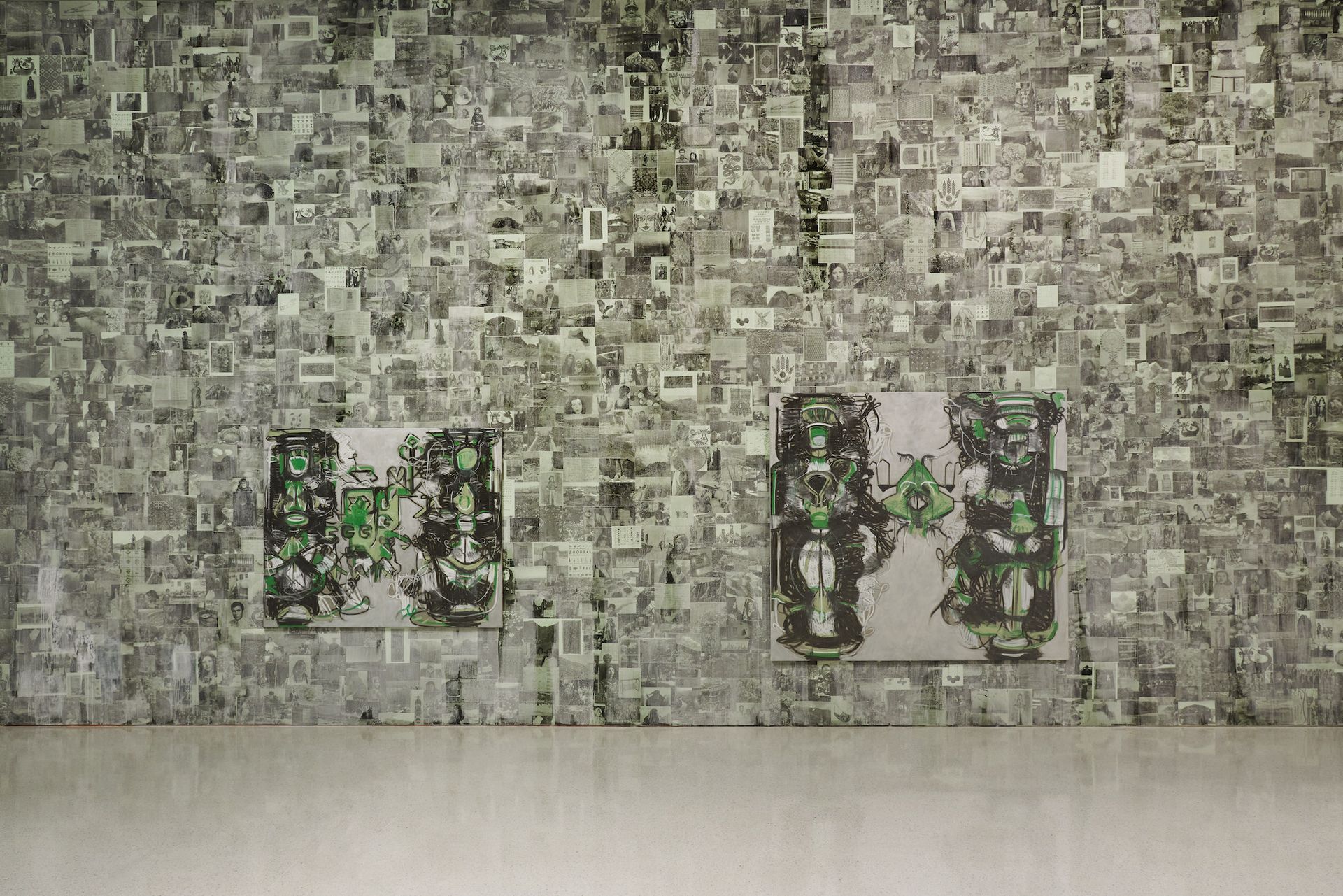
2.Melike Kara, installation view of qarajorlu / pahlevanlu (left), darreh gaz (dorunger valley / bajgiran region) (right) and weaving (background, all works 2022), in the 58th Carnegie International Courtesy of the artist and Carnegie Museum of Art; photo: Sean Eaton
At the far end of Heinz galleries, Vietnamese artist Trương Công Tùng examines the persistence of life despite the impacts of modernization and war. The artist considers his installation—comprising a circulatory network of gourds connected with industrial tubing—as a garden, the “eternal witness to our behaviours” that requires cultivation and care.
Tùng's work mirrors the curatorial intent to tend to and sustain an interconnected network of perspectives and expressions that defy our structural understanding. “Each work in the exhibition is a sound, a note in an orchestra that is played and controlled remotely,” says the artist. “It teases us and reveals discrete notes or fragmented pieces of music. However, it never tells us the sum of those notes, nor does it reveal to us the secret of their melody. Somehow, we need to find out the secret of those hidden tunes.”
Poetic interventions
In the museum’s central atrium, Paris-based Vietnamese artist Thu Van Tran infiltrates the space with an arresting series of frescoes entitled Colors of Grey, a reference to the chemical agents known as “Rainbow Herbicides” used by the US military to decimate 4.5 million acres of nature during the Vietnam War. Layering white, pink, green, blue, purple and orange hues onto the walls of the hall, designed after the Greek Parthenon to house the museum’s collection of plaster-cast replicas of Greek antiquities, Tran “stains” the room a melancholic grey, symbolically subverting the suppositions of authority implicit in the institutional white walls.

Thu Van Tran, installation view of Colors of Grey (2022), in the 58th Carnegie International Courtesy of the artist and Carnegie Museum of Art; photo: Sean Eaton
“The dominant, Western perspective is the one that has been archived in history” Tran says. “The white wall implies virginity and purity, but this is a lie—we are already starting from a stained history.”
Downstairs in the museum’s Heinz Architectural Center is Seismography of Struggle (2018-22), an expansive inventory of non-European critical and cultural journals from the African, Indian, Caribbean, Asian and South American diasporas dating from the late 18th century to 1989 selected by the French-Algerian author, curator and art historian Zahia Rahmani. Since 2015, she has worked with an international team of researchers to surface and archive a collection of catalogues, building an accessible database of more than 1,000 documents that trace a critical global history of radical and courageous defiance and expression in response to systems of colonialism, genocide, apartheid and slavery.
For the International, the archive includes a film installation and collection of physical publications from the American Left Ephemera Collection and materials borrowed from the University of Pittsburgh’s archives, documenting the struggle of Black people in the US, including the Freedom’s Journal, the first Black-owned and operated newspaper in the US, established in 1827. “Reading this publication, you could say it’s avant garde” says Rahmani. “That’s why we need this text.”
Reflecting the aim of the Refractions presentation upstairs, Rahmani’s extensive research is a practice in decentralisation, surfacing historical documents of resistance and cultivating a library of non-Eurocentric perspectives that reflect a global solidarity. “All of these people come from colonisation,” says Rahmani. “With time, you lose your identity and pride. But there are these resources and manifestos behind you. We need these resources for tomorrow, for the new generation.”
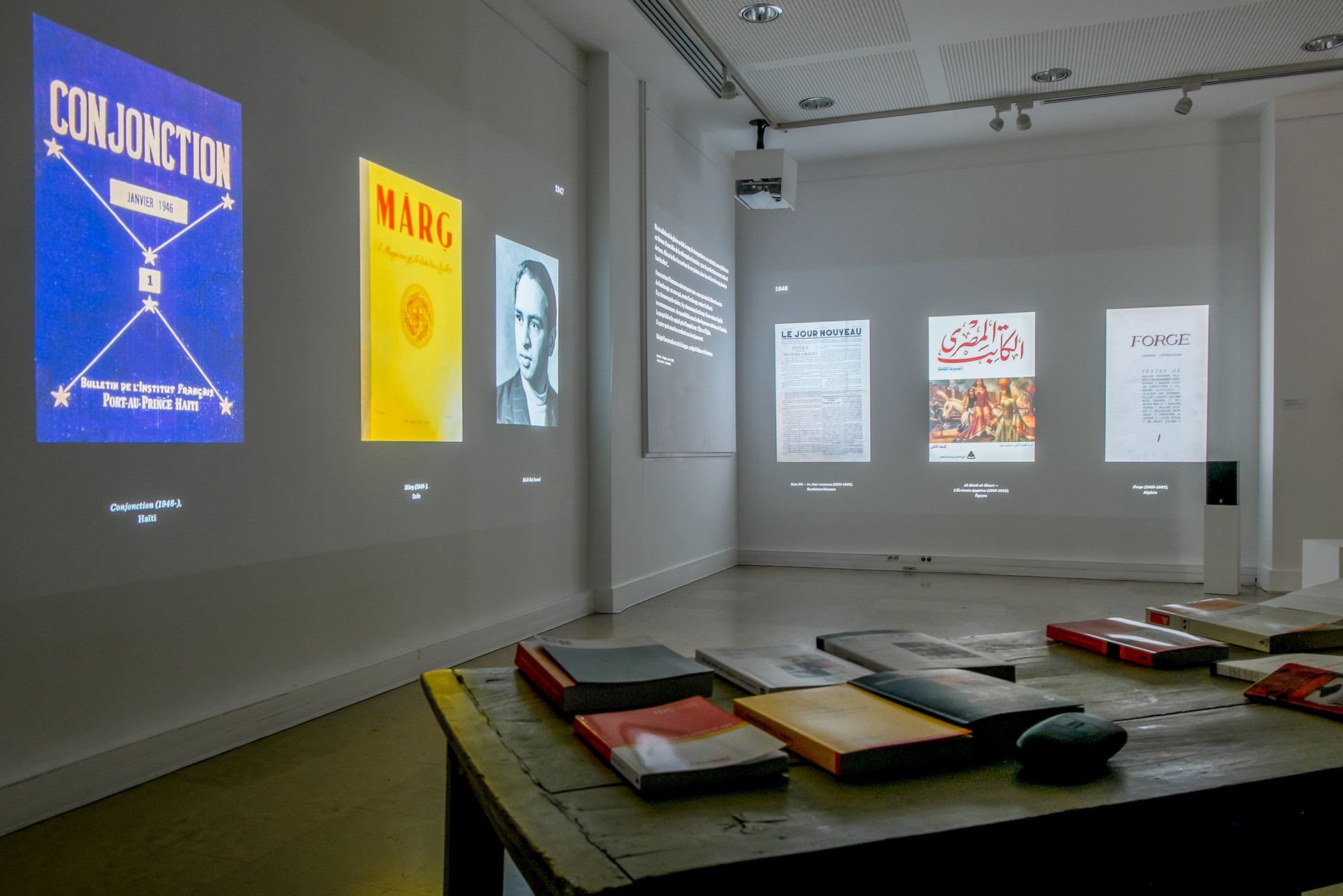
Zahia Rahmani, exhibition view of Seismography of Struggle—Towards a Global History of Critical and Cultural Journals at the French National Institute of Art History, Paris, 2017 Courtesy the artist
Staged in a small, dark room in the Heinz Architectural Center, Rahmani’s project is not given the space it deserves. Alongside other initiatives building artistic solidarity—including an international mail art project by Mexico City-based Colectivo 3 that compiles creative meditations on the theme of revolution, a selection of North Vietnam propaganda posters repurposed by students practising figure drawing during the Vietnam war and presented here by the Dogma Collection, and an intimate display of modern and contemporary art spanning three historical periods in Iran including the 1979 revolution and assembled by artist Fereydoun Ave—Rahmani’s project seems a conceptual afterthought, underscoring the intentions of the exhibition but not inviting visitors to spend time with the texts. Perhaps this reflects the sheer vastness of revolutionary visual invention that informs our present, overwhelming the confines of the institutions that have long omitted this rich global history.
Further down the corridor, nestled in a corner gallery, OK Studio by Julian Abraham “Togar” appears as an oasis of sound, inviting pause and contemplation. Consisting of nine automated ocean drums, gongs, contact mics and shruti boxes, the continually evolving project started as a series of percussive jam sessions at the Indonesian artist’s studio at Amsterdam’s Rijksakademie during the Covid-19 lockdown. The work, as the artist explains, is shaped by its environment, and “the possibilities that it carries to invite others to play with it, sit with it, move with it”.
At the Carnegie, the instruments are installed atop latticed wooden stools at the centre of the room, playing an entrancing composition that washes over visitors. Togar’s sonic installation bookends the exhibition with an aerating sense of optimism—a pause as opposed to a full stop.
- 58th Carnegie International: Is it morning for you yet?, until 2 April 2023, Carnegie Museum of Art, Pittsburgh, Pennsylvania.


